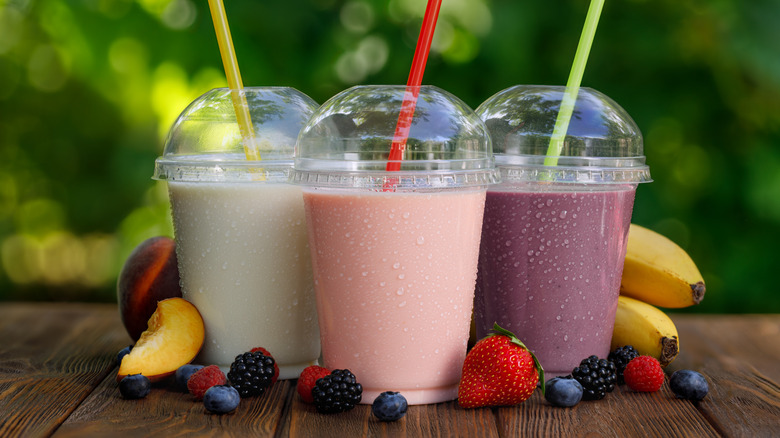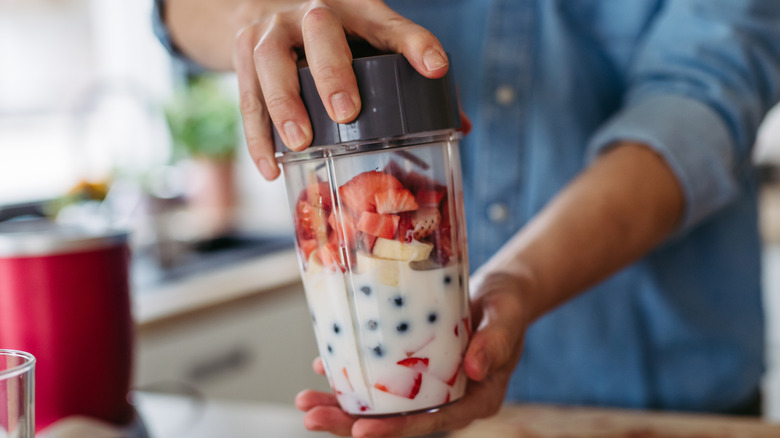Why Buying Prepared Smoothies At The Grocery Store Isn't Such A Life Hack After All
Creamy and flavorful smoothies, packed with nutrient-rich fruits, vegetables, and other ingredients, are popular as portable breakfasts or afternoon snacks. When you're on the go, it's easier to grab a smoothie from the grocery store instead of making it at home, but that may defeat the whole purpose of having one. Jennifer Pallian, BSc, RD (registered dietitian), and founder of Foodess, revealed to The Takeout that supermarket smoothies can actually be less nutritionally beneficial than they appear.
"Prepared grocery store smoothies may seem healthy, but they often contain juice, concentrates, or purees instead of whole fruits and vegetables," she told us. While that gives you the flavor of the fruits and vegetables, Pallian explained that you miss out on the benefits of having the actual fruit and its skin blended in. "These processed forms strip away fiber and some nutrients, making the smoothie less filling and potentially spiking blood sugar more quickly. They can also contain added sugars, which reduce the overall nutrient quality and contribute unnecessary calories," she said.
The potential nutritional drawbacks of store-bought smoothies are why making your own is worth the time and effort. "One of the main benefits of making smoothies at home is that you have full control over what goes in," Pallian said. "Plus, homemade smoothies are easier to tailor to your specific health goals," she added.
How to make the best homemade smoothies
A basic ratio for smoothies is two parts fruit or vegetables to one part liquid, plus fun add-ins like vanilla extract, spices, nut butters, seeds, or yogurt. If you have a blender with a cap opening, start by whirring the liquid into a whirlpool. Juice, water, milk, and non-dairy milks are common options. Add any sweeteners or powders to dissolve them, followed by the fresh fruits and veggies. As you add the ingredients, the moving liquid efficiently brings them down to the blades. Ice and frozen produce should be added last. If you're using a bullet or immersion blender, blend the liquid and soft ingredients together first before incorporating hard or frozen additions so the machine doesn't have to work too hard.
Using frozen fruit has the benefit of chilling and thickening the smoothie, but fresh fruit is great too. "Using fresh, seasonal produce also makes homemade smoothies more affordable and nutrient-dense since in-season fruits and vegetables tend to be at their peak quality and cost less," Jennifer Pallian shared. If you get a good deal on a haul of fresh produce, freeze it yourself so it doesn't go bad.
For the most nutritious homemade drink, "Balance your smoothie with protein, fiber, healthy fats, and complex carbs," Pallian said. Add-ins like avocado and nuts lend fats, and there's fiber in flaxseed, wheat germ, and even cooked white beans. Get protein from Greek yogurt, protein powder, or silken tofu, the secret ingredient for protein-rich smoothies. Whole grains, nuts, seeds, and all the fruits and veggies provide complex carbohydrates. You may need a sweetener like honey, maple syrup, or dried fruit, and don't forget a pinch of salt, an unexpected addition needed for a better tasting smoothie.

